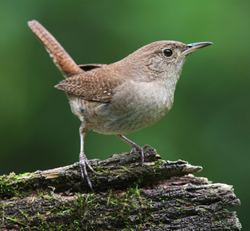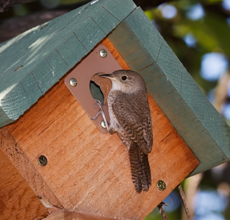 Identification
Identification
Distinct for its musically rich and bubbling song, the House Wren is a common and delightful bird to host in your backyard. A small bird, the House Wren comes in at just under 5″ long and is brown from beak to tail with slight markings on the tail and wings. It has a slightly curved beak and a light eye-ring. The female House Wren is the same as the male. Look for a flicked-up tail, a common stance for this little bird.
 Habitat and Nesting
Habitat and Nesting
House Wrens have one of the largest distributions of any songbird. (Canada to West Indies, to the tip of Argentina). In Minnesota, they are summer visitors only, migrating to the southern states and Mexico each winter. House Wrens live in a range of habitats, from open woods and thickets, to town parks and backyards. They often nest in bird houses.
Each spring, males return approximately 9 days earlier than females to claim their territory and start a number of prospective nests. When the female arrives, she investigates each nest and chooses one to complete. A nest may contain as many as 500 sticks. Scientists believe wrens also use spider egg sacs in their nests to help reduce the number of mites. The eggs hatch and the baby spiders dine on the mites!
Nests may have 4–6 tan eggs, incubating for 10–13 days with the help of both the male and female wrens. Young fledge in 12–15 days; both parents feed the young.
Diet
House Wrens mostly eat insects, including: beetles, true bugs, grasshoppers, crickets, caterpillars, moths, flies, spiders, plus some millipedes and snails. They are not typical visitors to feeding stations.

